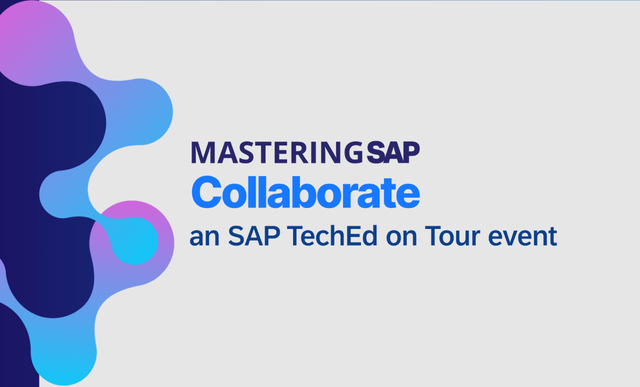SAP Analytics and AI
SAP AI | SAP Analytics | SAP Analytics Cloud | SAP BI Tools | SAP Business Intelligence | SAP BusinessObjects | SAP Data Science | SAP Lumira | SAP Machine Learning | SAP Predictive Analytics
Filter By
Browse By
- SAP Analytics and AI
- SAP Application Development and Integration
- All SAP Application Development and Integration
- SAP ABAP
- SAP ABAP Development Tools
- SAP ABAP Test Cockpit
- SAP API Management
- SAP BAPI
- SAP Basis
- SAP BRF
- SAP Business Application Studio
- SAP CMS
- SAP Design Studio
- SAP Development Tools
- SAP DevOps
- SAP EAI
- SAP EDI
- SAP Extension Suite
- SAP Fiori
- SAP Fiori Elements
- SAP Integration Suite
- SAP Low Code Application Development
- SAP Low Code Automation
- SAP Netweaver
- SAP Release Management
- SAP UI5
- SAP Web Application Server
- SAP Web IDE
- SAP Business Process Management
- SAP Center of Excellence
- SAP CIO
- SAP Customer Experience
- SAP Data and Data Management
- All SAP Data and Data Management
- SAP BW
- SAP BW/4HANA
- SAP Crystal Reports
- SAP Data Archiving
- SAP Data Center
- SAP Data Governance
- SAP Data Integration
- SAP Data Migration
- SAP Data Quality
- SAP Data Services
- SAP Data Strategy
- SAP Data Visualization
- SAP Data Warehouse Cloud
- SAP DMS
- SAP Document Control
- SAP EIM
- SAP ETL
- SAP ETL Tools
- SAP HANA
- SAP HANA Administration
- SAP HANA Deployment Infrastructure
- SAP HANA Studio
- SAP Master Data
- SAP Master Data Governance
- SAP MDM
- SAP Enterprise Architect
- SAP Enterprise Asset Management
- SAP ERP
- SAP Finance
- All SAP Finance
- SAP Accounting
- SAP AR AP
- SAP Asset Accounting
- SAP Billing Systems
- SAP BPC
- SAP BRIM
- SAP Cash Management
- SAP Central Finance
- SAP Controlling
- SAP COPA
- SAP Cost Center Accounting
- SAP Currency Risk
- SAP e-invoicing
- SAP FICO
- SAP Finance Automation
- SAP Advanced Financial Closing
- SAP Financial Consolidation
- SAP Financial Planning
- SAP FX Risk
- SAP General Ledger
- SAP Global Tax Management
- SAP Hyperion
- SAP Order to Cash
- SAP Payment Processing
- SAP Profitability Analysis
- SAP Rebate Management
- SAP S/4HANA Finance
- SAP SWIFT Compliance
- SAP Treasury Management
- SAP Universal Journal
- SAP Governance Risk and Compliance
- SAP Human Capital Management
- SAP Intelligent Technologies
- SAP Platform and Technology
- All SAP Platform and Technology
- SAP Business Technology Platform
- SAP Cloud
- SAP Cloud Connector
- SAP Cloud Integration Platform
- SAP Cloud Migration
- SAP Cloud Platform
- SAP Cloud Providers
- SAP Cloud Strategy
- SAP Digital Signature
- SAP Container Platform
- SAP HANA Enterprise Cloud
- SAP Digital Asset Management
- SAP Smart Forms
- SAP HEC
- SAP Digital Integration Hub
- SAP Hyperscalers
- SAP Infrastructure
- SAP Messaging
- SAP Quality and Testing
- SAP Security
- SAP Spend Management
- SAP Supply Chain Management
- All SAP Supply Chain Management
- SAP APO
- SAP Asset Management
- SAP Business Network
- SAP Digital Manufacturing Cloud
- SAP Digital Twin
- SAP EWM
- SAP IBP
- SAP Inventory Management
- SAP Label Printing
- SAP Logistics
- SAP Manufacturing
- SAP Manufacturing Automation
- SAP MES
- SAP MII
- SAP MM
- SAP MRO
- SAP MRP
- SAP Order Management
- SAP Plant Maintenance
- SAP PLM
- SAP Production Planning
- SAP S&OP
- SAP SD
- SAP SPM
- SAP Supply Chain Planning
- SAP Track and Trace
- SAP Transportation Management
- SAP System Administration
Artificial Intelligence (AI) and analytics play a key role in digital transformation initiatives. As advances in technology and computing power accelerate the digitalization journey, companies across industries are generating gigantic volumes of data daily. The value of this data lies in leveraging it to draw actionable insights, planning and innovation. This is where AI and analytics come into picture, acting as key tools to harness the value from data being generated and collected across the enterprise. Analytics is generally classified into categories like descriptive, prescriptive, diagnostic, and predictive. AI algorithms help in predictive and prescriptive analytics, but they also enable companies to build innovative capabilities like Industry 4.0.
SAP and Partner Technologies in Analytics and AI
Artificial Intelligence (AI) and analytics play a key role in digital transformation initiatives. As advances in technology and computing power accelerate the digitalization journey, companies across industries are generating gigantic volumes of data daily. The value of this data lies in leveraging it to draw actionable insights, planning and innovation. This is where AI and analytics come into picture, acting as key tools to harness the value from data being generated and collected across the enterprise. Analytics is generally classified into categories like descriptive, prescriptive, diagnostic, and predictive. AI algorithms help in predictive and prescriptive analytics, but they also enable companies to build innovative capabilities like Industry 4.0.
SAP and Partner Technologies in Analytics and AI
SAP and their partner ecosystem have rich portfolio of tools and technologies in AI and analytics domain. SAP BTP platform has AI and analytics capabilities embedded to help organizations build intelligent enterprise capabilities. SAP S/4HANA puts AI in the ERP, whereas SAP Intelligent Automation uses AI to help organizations build smart automation capabilities. Digital supply chain tools from SAP leverage AI and analytics with emerging technologies to help organizations build smart supply chains. AP Analytics Cloud is the leading enterprise analytics tool in the market and is seen as the future of SAP Business Objects. The partner technology ecosystem is not behind. In every function, SAP partners offer AI-enabled tools like Phenom AI for HR processes, iCertis for contract lifecycle management, Prospecta for intelligent data management. Then there are overarching analytics solutions from partners like Pyramid Analytics that help build enterprise-wide decision intelligence capabilities.
Resources for SAPinsiders
Key Insights Using SAP Analytics Cloud: In today’s world, data is becoming more valuable every. For any organization, it is necessary to analyze their data before making any critical decisions regarding business operations such as finance, sales, supply chain operations and more. For enterprises with large amounts of critical,, but under-analyzed, data, SAP Analytics Cloud has simplified and expedited data analysis. This article discusses how organizations can draw critical insights using SAP Analytics Cloud.
Three-Step Gameplan to Deploy AI in the Office of CFO: While the world witnessed the emergence of self-driving cars with advanced technologies, such as artificial intelligence (AI) and machine learning (ML), the world of finance has also done everything to keep up. A/R operations are now getting more autonomous and intelligent while the workforce is focusing more on ‘strategic’ business decision making. 65% of finance executives reported that they increased their technology investments and are now focusing on growing their digital business in 2021. This webinar shares a roadmap to leverage AI in finance executive planning.
498 results
-

 Premium
Premium
How to Develop Real-Time Analytics and a Monitoring Dashboard on SAP MII SSCE
Reading time: 27 mins
Learn how to use the Self-Service Composition Environment (SSCE) in SAP Manufacturing Integration and Intelligence (SAP MII) 15.0 to quickly develop real-time analytics and monitoring dashboards by fetching data from multiple sources. Key Concept The Self-Service Composition Environment (SSCE) is a new feature in SAP Manufacturing Integration and Intelligence (SAP MII) 15.0 that enables you...…
-

- SAP HANA
 Premium
Premium
Information Management Options in SAP HANA: Smart Data Quality
Reading time: 12 mins
SAP HANA has features to both manage data and improve data quality that many SAP users might not know exist. These new options offer real-time transformational possibilities that were unthinkable until recently. Learn about the tools you can use to cleanse, match, or enhance data in real time with Smart Data Quality. Key Concept Many...…
-

- SAP Fiori
 Premium
Premium
Begin Your Supply Chain Transition to SAP Fiori in SAP S/4HANA
Reading time: 13 mins
Learn how to plan the transition of your SAP S/4HANA supply chain business function execution from your current ERP-based conventional approach to SAP Fiori. Key Concept SAP Fiori extends the core operational capabilities that SAP S/4HANA provides with apps for your key SCM business processes with a completely new user interface. SAP Fiori, SAP’s new...…
-
-

 Premium
Premium
Enterprise Information Management: What, Why, Where, and How
Reading time: 17 mins
Understand how SAP solutions for enterprise information management (EIM) cover all types of information. This includes data that is structured, semi-structured, or unstructured, as well as many content forms such as documents, emails, and PDFs. It also supports business processing and analytical applications, and evolves into information governance to ensure data and information are managed...…
-

 Premium
Premium
Are Your Skills Up to Date for the Age of SAP HANA?
Reading time: 18 mins
/HANASAP’s recent innovations, including SAP HANA, are likely to cause a skills gap in the SAP community going forward. Experts trained on classical ERP or analytics systems don’t necessarily have the right skills for the future. Get a first-hand look at some of the new skills that you need to successfully embrace the change. Learn...…
-

- SAP HANA
 Premium
Premium
Dolby Delivers Emotionally Charged Experiences with Next-Generation SAP HANA Database
Reading time: 14 mins
Dolby Laboratories, a leader in audio, video, and voice technology, has always been on the technological cutting-edge. But when it came to internal business intelligence (BI) solutions, Dolby had room for improvement. Lengthy delays, data redundancy, and lack of agility hampered the company from deriving insights as fast as it wanted. Learn about Dolby’s journey…
-

- SAP Data Strategy
 Premium
Premium
Merck Focuses on Data-Driven Platform Strategy
Reading time: 7 mins
Merck & Co., one of the world’s largest healthcare companies, has seen its data explode since it first implemented SAP Business Warehouse (SAP BW) on a third-party database that started to struggle as Merck’s massive data volumes hit the 15TB mark. To enable deep analytics insights and real-time access to all its growing data, Merck…
-
-

- SAP Analytics
 Premium
Premium
Rainforest Connection to Use Predictive Analysis to Fight Deforestation and Protect the Global Environment
Reading time: 8 mins
Deforestation is devastating to Earth’s rainforests, and to the planet as a whole — it creates more of an impact on climate change than the emissions of planes, trains, cars, trucks, and ships combined, according to a study. With 90% of rainforest logging being done illegally, a massive opportunity opened up for Rainforest Connection, a…
-

- SAP ERP
 Premium
Premium
adidas group Hits the Ground Running
Reading time: 8 mins
adidas group knows that a simplified IT landscape and reduced operational costs over the next few years will be important in helping the company reach its ambitious goal of reaching €17 billion by 2015. See how adidas group consolidated its business warehouse environment onto a single SAP HANA platform; implementing SAP NetWeaver Business Warehouse 7.3…
-

Digital Innovation in Sourcing and Procurement
Reading time: 6 mins
Supplier relationships play a major role in determining an organization’s bottom line, and when suppliers are not performing at an optimal level, businesses need to know immediately or risk losses. Procurement professionals, many of whom have to deal with an ever-increasing volume of suppliers and contracts, face a growing burden in managing these supplier relationships.…
Become a Member
Unlimited access to thousands of resources for SAP-specific expertise that can only be found here.
Become a Partner
Access exclusive SAP insights, expert marketing strategies, and high-value services including research reports, webinars, and buyers' guides, all designed to boost your campaign ROI by up to 50% within the SAP ecosystem.
Upcoming Events
-

Mastering SAP Collaborate, an SAP TechEd on Tour event
November 12 - 14, 2025
Sydney, New South Wales
Australia
View Event
Related Vendors
Your request has been successfully sent

